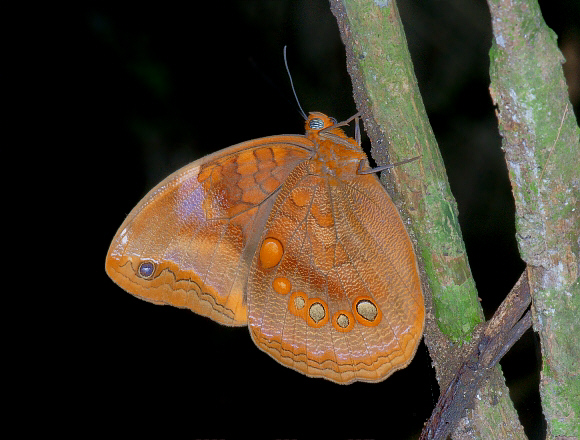 Catoblepia berecynthia, Pantiacolla, Rio Alto Madre de Dios, 550m, Peru – Adrian Hoskins
Catoblepia berecynthia, Pantiacolla, Rio Alto Madre de Dios, 550m, Peru – Adrian Hoskins
Introduction
A few decades ago the Owl butterflies were considered to be members of a now defunct family, the Brassolidae. Following revisions by Erlich and Ackery all butterflies with only 2 pairs of fully formed walking legs were placed in the Nymphalidae. The Brassolidae were consequently reduced in rank to a subfamily Brassolinae, then relegated further to become the Brassolini – a tribe of the Morphinae.
The Morphinae includes about 150 neotropical species, 93 of which are placed in the tribe Brassolini. Of these, 73 are placed in the Brassolina – a subtribe which includes Blepolenis, Brassolis, Dynastor, Caligopsis, Catoblepia, Dasyopthalma, Mielkella, Opsiphanes, Mimoblepia, Opoptera, Selenophanes, Penetes, Eryphanis, Orobrassolis and Caligo. All are crepuscular or nocturnal in behaviour although a few species also fly by day in the darkest areas within their habitats. They are among the oldest butterflies on Earth – Brassolis e.g. first evolved in the late Eocene, about 40 million years ago.
There are 8 species in the genus Catoblepia, distributed variously from Belize to Bolivia.
There are considerable differences in the underside patterning of these 8 species. Some, including berecynthia and generosa are quite plain, with small inconspicuous ocelli that are roughly equal in size. Some other species such as amphirhoe and orgetorix ( = sticheli ) are much more prominently marked, and have only two ocelli, but these are much larger in size and give the butterflies a more Caligo-like appearance. On the upperside all Catoblepia species are dark brown with a blue sheen. There is a dull orange diagonal subapical band on the forewings. Some species also have a similarly coloured submarginal band on the hindwings.
Catoblepia berecynthia is the commonest and most widespread member of the genus, being found from Nicaragua to Bolivia.
 Catoblepia berecynthia ( Peru ), wing scales, highly magnified – Adrian Hoskins
Catoblepia berecynthia ( Peru ), wing scales, highly magnified – Adrian Hoskins
Habitats
This species is found in primary rainforest at altitudes between 0-900m.
Lifecycle
The egg is pale green. It is laid singly on palms ( Arecaceae ). The larva is pale brown with darker longitudinal stripes. It’s tail bears a pair of caudal prongs and it’s head is adorned with a crown of 6 short horns.
Adult behaviour
The butterflies are active mainly in the pre-dawn period, and again to a lesser degree at dusk. On dull days they may also be found feeding at decomposing fruit on the forest floor, or at sap runs.
